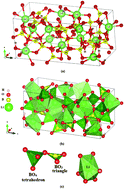Lithium borate Li3B5O8(OH)2 with large second harmonic generation and a high damage threshold in the deep-ultraviolet spectral range†
Abstract
The electronic structure and linear and nonlinear optical susceptibility dispersions of lithium borate Li3B5O8(OH)2 are comprehensively investigated. The investigation is achieved on Li3B5O8(OH)2 in the form of single crystals, taking into account the influence of the packing of the structural units on the linear and nonlinear optical susceptibility dispersion. The calculations highlight that the BO3 structural unit packing is the main source of the large birefringence in Li3B5O8(OH)2 due to the high anisotropic electron distribution, and, hence, it affects the macroscopic second harmonic generation (SHG) coefficients. This work provides a new path for the design of UV-NLO materials with high SHG efficiencies and short cutoff edges by introducing an alkali metal into borates. The large SHG is due to hyperpolarizability formed by co-parallel BO3 triangle groups. The absorption edge of Li3B5O8(OH)2 occurs at λ = 190 nm and the optical band gap is estimated to be 6.52 eV, which is in good agreement with the experimental data (6.526 eV). The energy gap value confirms that Li3B5O8(OH)2 exhibits an exceptional laser damage threshold and is expected to produce coherent radiation in the deep-ultraviolet (DUV) region. The obtained value of SHG at λ = 1064 nm is about 1.5 times that of the well-known NLO crystal KH2PO4 (KDP) at λ = 1064 nm and 3.5 times that of KDP at λ = 190 nm, which is transparent down to the DUV region. Thus, one can conclude that the combination of an alkali metal with borates leads to the generation of promising DUV-NLO crystals. This work is aimed at qualitative and quantitative investigation to report a reliable SHG value and provide details of the NLO tensor for bulk Li3B5O8(OH)2 single crystals.



 Please wait while we load your content...
Please wait while we load your content...